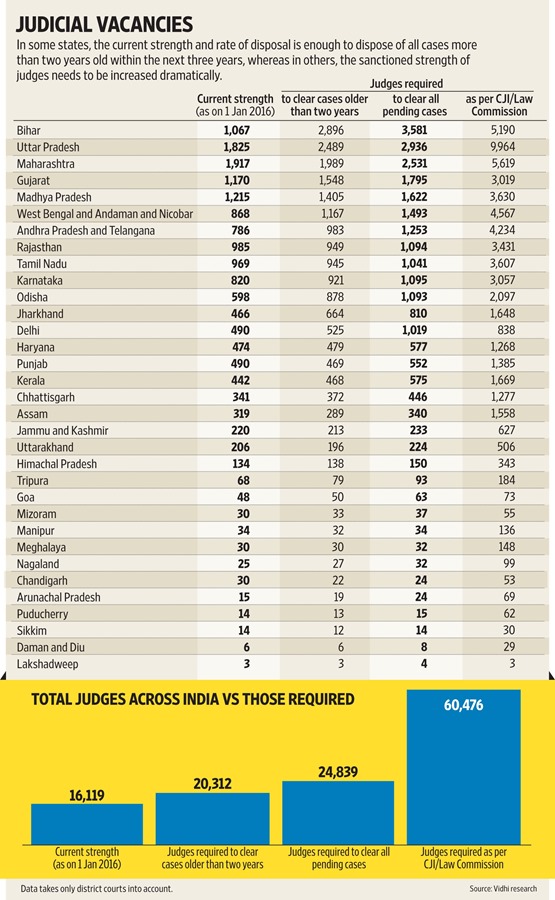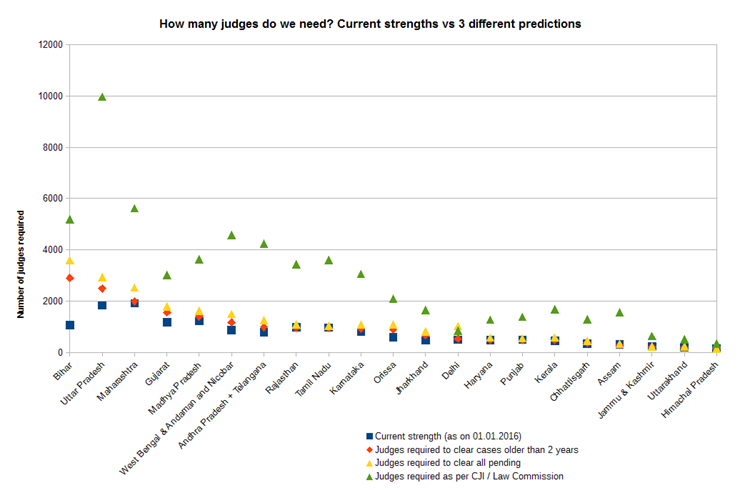
In most years, the annual Joint Conference of Chief Justices and Chief Ministers gets barely a passing mention in media outlets and is forgotten soon after.
This year it was different.
Chief Justice of India TS Thakur’s dramatic outburst in April about the “burden” being placed on the judiciary had firmly brought the spotlight back on to the issue of judicial delays and backlogs in India. He lamented the delays in trial which has seen the burgeoning of the numbers of under-trial prisoners and trials which decades to complete, pointing to the inadequacy in the judicial strength as the prime cause.
In May, Thakur then quantified this inadequacy with an astonishing claim: that India needs 70,000 judges to clear the pending cases.
Where does the 70,000 judge target come from?
The basis for this, as his speech at the Conference of Chief Justices and Chief Ministers indicates, is the benchmark of having 50 judges per million population.
With India’s population being pegged at 1.2 billion as of May, 2016, applying this benchmark, India should have approximately 60,000 judges. As on 1 January, 2016, according to the “Court News” publication of the Supreme Court of India, there were 16,119 judges in the subordinate judiciary, 598 judges in the High Courts and 26 in the Supreme Court.
The latest figures (as on 11.07.2016), as seen from the National Judicial Data Grid and Department of Justice data, tell us there are 16,438 judges at the subordinate judiciary level, 621 in the High Courts and 29 at the Supreme Court. All of this suggests that getting anywhere close to the Chief Justice’s benchmark of 70,000 or even 65,000 is going to be a herculean, if not nigh impossible for a few decades.
However, a fundamental question needs to be answered: Do we actually need 70,000 judges to dispose of the pending 3.2 crore cases in the Indian judicial system?
The numbers suggest otherwise.
For a start, even at present strength, courts dispose almost as many cases as are filed in a given year.
For instance, between July, 2014 and July, 2015 with a working strength between 15,500 to 15,600 judges, the subordinate courts in India disposed of about 1,87,30,046 cases as against 1,86,25,038 cases which were filed in the same time period – just a little more than the number of cases filed.
This must give us pause to question once again the basis for the figure of 70,000 judges.
The Law Commission methodology
The origin of the benchmark of “50 judges per million” lies in the 120th Report of the Law Commission of India.
That report itself is very laconic. It is all of five pages long.
While it suggests that rate of pendency or rate of litigation as a basis to fix the judge strength, it doesn’t actually carry out the mathematical exercise of arriving at a number on the basis of available data.
Rather, the Law Commission looks at numbers of judges in other countries such as the United States and decides India should have as many judges as the USA at least, without comparing the number of cases in the system, the underlying economy, and the capacity of the judicial system to handle the workload.
The basis to argue for a benchmark of 50 judges per million is flimsy, to say the least.
But how many judges does India actually need?
An alternative methodology
A case cannot be disposed in a mechanical fashion like the post office. One or more hearings have to take place, evidence has to be presented and the judge has to apply her mind. A proper time frame for the disposal of a case has to be fixed. Assuming that an outer limit of three years is fixed, we can assess how many judges we need to dispose of existing loads of cases, whether they were filed yesterday or ten years ago.
This methodology was adopted by the Law Commission of India in its 245th Report “Arrears and Backlog: Creating Additional Judicial (wo)manpower” and is also routinely used within Governments and the judiciary to assess judge strength.
Another way to approach the need for additional judges is to what role they are going to play within the judicial system – are they needed to handle the entire incoming load or the existing backlog.
The numbers tell us that the present strength is about adequate to ensure that number of pending cases doesn’t increase too much on a year to year basis. Therefore, it might be the case that what India really needs are more judges to handle the backlog, i.e, pending cases which haven’t been disposed of for a long time.
There are two good alternative ways of looking at solving the pendency problem within three years by calculating how many additional judges are required to hypothetically:
1. dispose of all cases currently in the system.
2. dispose only cases that have been in the system for more than two years, since the judiciary appears to be able to deal with the current incoming workload of cases somewhat adequately.
For the purpose of this analysis, we will focus on the district courts.
The data
Data on the time period for which a case has been pending as on 31.12.2015 in the district courts has been obtained from the Department of Justice, which itself obtained this data from the jurisdictional high courts directly.
Looking at the numbers available in the “Court News” Publication of the Supreme Court which contains details of the cases filed and disposed in the trial courts, it is possible to see the average number of cases a judge disposed in a year.
Since the manner of counting a case is different in each State, the five-year average rates of disposal in each state vary.
The wide variance seen in the number of cases disposed per judge can be attributed to the fact that not all states count what is a case in the same way. Some courts count only the main case whereas some others include the interim applications and miscellaneous proceedings within that case separately. Be that as it may, this gives us some idea how many judges each state would need to dispose of its particular backlog.
Applying this rate to the pending cases, we can figure out how many additional judges are needed, depending on whether we're looking to dispose of all pending cases in three years or just the cases older than two years.
Far fewer judges required than expected
The overall picture suggests that the number of additional judges needed is much lower than the figure cited by the Chief Justice of India.
And in some states, the current strength and rate of disposal is enough to dispose of all cases more than two years old within the next three years, whereas in others, filling up the current vacancies would serve the same purpose.
However, there are some states where the sanctioned strength of judges needs to be increased dramatically do to do so.
As the numbers show, with either of the objectives, Bihar clearly has the worst problem of lack of judicial capacity in the lower courts, whereas Odisha and Jharkhand also have significant problems on this front. Another way to look at it could also be to show that the judicial systems in these states don’t function very efficiently.
It might mean that the pendency and delay might come down if the courts just functioned more efficiently, with fewer adjournments, more hearings, better infrastructure and support.
Even so, going by the information in the Court News publication, most of the states would be able to handle the burden of pending cases if they appoint a reasonable number of judges in addition to their existing strength.
However, the figure cited by the Chief Justice of India, with respect, appears entirely unreasonable and not based on a rational assessment of the needs of the system. On the other hand, it is also taking away attention from the manifold other changes needed to the judicial system.
Judges alone are not the answer
For a start, even if one were to accept that more judges are necessary, the present quality of lawyers and the appointment mechanisms don’t make scaling up (even to the modest numbers suggested in this article), entirely feasible.
Either the quality requirements will have to be seriously compromised (unacceptable) or the terms and conditions of service of being a judge must be vastly improved, involving heavy, recurring expenditure for the states.
Other options, such as changes in procedure, improved quality of law graduates, greater use of information technology, alternate dispute resolution must all be explored to ameliorate the situation.
In actually implementing judicial reform, a credible cost-benefit analysis is imperative.
For that we need a dispassionate data driven approach to the problem and understanding of the limitations of the legal ecosystem we are working in. Adding to the strength of the judiciary is no doubt necessary to some extent, but it should not occupy all the energies and resources available.
Alok Prasanna Kumar is a senior resident fellow at the Vidhi Centre for Legal Policy. Additional research to this story contributed by Vidhi interns Kanika Sood and Akshay Shandilya.
This article was first published in Mint. Mint's association with LegallyIndia.com will bring you regular insight and analysis of major developments in law and the legal world.

threads most popular
thread most upvoted
comment newest
first oldest
first
threads most popular
thread most upvoted
comment newest
first oldest
first